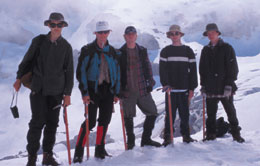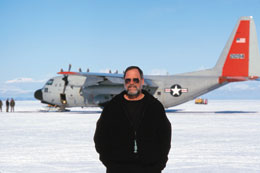Science in Antarctica is hard on people and hard on equipment. Still, scientists from around the world clamor to go there, because Antarctica provides a unique environment for some of the most exciting research on earth. Six times now St. Olaf Professor of Physics Bob Jacobel has been among those privileged to work there, most recently in October 1999.
His earlier projects took Jacobel to Antarctica to examine the activity of fast ice streams at the western edge of the Ross Sea using special ice-penetrating radar. Last year, however, he spent three months there as a principal investigator on a project which involves analyzing ice cores for evidence of atmospheric and climatic changes.
“Nuclear tests, lead and other chemicals, Chernobyl, the ozone hole and natural events like El Niño and volcanic eruptions — they’re all recorded in the ice of Antarctica,” said Jacobel, who also serves as director of the Environmental Studies program at St. Olaf.
 |
|
The Antarctic Ice Radar and Remote Sensing Group is a National Science Foundation sponsored research project in which the main goal is to understand the response of the world’s ice masses to global change. Students are involved with projects in the Washington Cascades and in the fast ice streams and the interior of the West Antarctic Ice Sheet. |
Because Antarctica receives just less than eight inches of precipitation annually, it qualifies as the earth’s largest desert — yet the ice cap contains more than 90 percent of the earth’s fresh water. Frozen within the ice are layers of dust, air bubbles, meteorites, pollen and other impurities that give scientists a diary of the past 200,000 years.
Between 1999 and 2002 scientists of the International Trans-Antarctic Scientific Expedition (ITASE) plan to extract two dozen 80-meter-long core samples from four separate areas of the deep mantle of ice that covers west Antarctica. Their research integrates meteorology, chemistry, surface glaciology and geophysics.
It also requires remote sensing. That’s where Jacobel comes in. He spent the summer of 1999 working with six St. Olaf physics students on a radar system designed to see into the Antarctic ice with better resolution. When he took the device with him last year to test it, he discovered again how harsh science at the bottom of the world can be.
Delayed at McMurdo Station for two weeks due to poor conditions, the scientists were then beset by equipment failures. While they were able to pull ice cores to analyze, they discovered that the radar system simply couldn’t function properly in such cold and they had to rely on an older backup system.
 |
| Bob Jacobel, homeward bound from Antarctica. LC-130 traverses the Southern Ocean in 8.5 hours to Christchurch, New zealand. All seats are ‘first-class.’ |
“It’s exciting to go to the Antarctic,” said Jacobel. “But you end up working all the time. There’s 24 hours of daylight and people tend to work seven days a week, 16 to 18 hours a day. It is cold, and the polar winds are continuous.”
What he finds hardest, however, is the psychological staleness: “There’s a loss of visual stimulation. Everything’s white on white. When you get back, you want to hug a tree.”
RELATED LINKS
CESGIC, the Center for Geophysical Studies of Ice and Climate